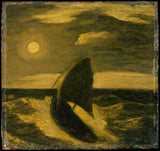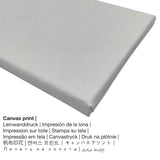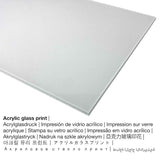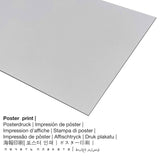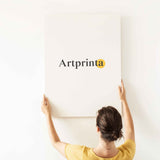Albert Pinkham Ryder, 1880 - The Toilers of the Sea - ọmarịcha nka
Ụtụ gụnyere. Mbupu gbakọrọ na ndenye ọpụpụ.
Nkọwapụta ngwaahịa nka
Nke a na narị afọ nke 19 bụ ndị mere American painter Albert Pinkham Ryder in the year 1880. The 140 A na-ese ụdị ihe osise dị afọ na nha: 11 1/2 x 12 inch (29,2 x 30,5 cm). Mmanụ na osisi was applied by the North American artist as the technique for the artwork. The work of art can be viewed in in the Ụlọ ihe ngosi nka nke Metropolitan nchịkọta dijitalụ na New York City, New York, Njikota Obodo Amerika. a nkà nke oge a ngalaba ọha artpiece na-ọnọ n'ikike nke Ụlọ ihe ngosi nka nke Metropolitan, New York, George A. Hearn Fund, 1915. The creditline of the artpiece is the following: George A. Hearn Fund, 1915. Further, the alignment of the digital reproduction is square ma nwee oke nke 1: 1, nke pụtara na ogologo ya na obosara. Albert Pinkham Ryder was a male artist, painter, whose style can be classified as Symbolism. The Symbolist painter was born in 1847 in New Bedford, Bristol county, Massachusetts, United States and died at the age of 70 na 1917 na Elmhurst, New York City, New York steeti, United States, agbataobi.
Họrọ ihe ị ga-ekwu
Nchịkọta nhọrọ ngwaahịa na-enye gị ohere ịhọrọ ihe na nha ọkacha mmasị gị. Nhọrọ ndị a dị maka n'otu n'otu:
- Mpempe akwụkwọ (ihe kwaaji): A poster is a UV printed sheet of canvas paper with a granular finish on the surface, which resembles the actual version of the masterpiece. Please note, that depending on the absolute size of the canvas poster print we add a white margin of something between 2-6cm round about the artwork, which facilitates the framing.
- Mbipụta kwaaji: The canvas print, not to be confused with a painting on a canvas, is an image printed on an industrial printing machine. In addition to that, a printed canvas makes a nice and pleasing look. Canvas prints are relatively low in weight, meaning that it is easy and straightforward to hang up your Canvas print without any wall-mounts. Therefore, a canvas print is suitable for any type of wall.
- Mbipụta enyo acrylic: The print on acrylic glass, often labelled as a an art print on plexiglass, transforms your favorite original artwork into lovely wall décor and makes a great alternative option to canvas or dibond prints.
- Aluminom dibond mbipụta (ọla): An Aluminium Dibond print is a print with an outstanding depth effect - for a modern look and non-reflective surface. For the Aluminium Dibond print, we print your selected artwork right onto the aluminium composite white-primed surface. The bright & white sections of the work of art shimmer with a silk gloss but without the glow. This direct UV print on aluminium is one of the most demanded entry-level products and is a truly contemporary way to showcase fine art prints, because it puts all of the viewer’s focus on the artwork.
Ederede iwu dị mkpa: We try the best we can in order to describe our art products as precisely as possible and to illustrate them visually. Although, the pigments of the printed materials, as well as the print result may diverge to a certain extent from the image on the device's screen. Depending on the settings of your screen and the nature of the surface, colors may not be printed 100% realistically. Bearing in mind that all the art reproductions are printed and processed manually, there might as well be slight differences in the motif's exact position and the size.
Banyere ihe
| Nkewa ngwaahịa: | ezi nka mmeputakwa |
| Mmeputakwa: | dijitalụ mmeputakwa |
| Usoro mmepụta: | Mbipụta UV / dijitalụ |
| Mmalite nke ngwaahịa a: | German mere |
| Ụdị ngwaahịa: | mmepụta ihe na-achọ |
| Ihe eji eme atụmatụ: | foto mgbidi, ihe ndozi ụlọ |
| Ntuziaka onyonyo: | nhazi square |
| Oke akụkụ onyonyo: | 1: 1 |
| Oke akụkụ pụtara: | ogologo ya na obosara |
| Ihe mmeputakwa dị: | Mbipụta iko acrylic (nwere ezigbo mkpuchi iko), mbipụta ọla (aluminium dibond), mbipụta akwa akwa, mbipụta akwụkwọ mmado (akwụkwọ kwaaji) |
| Nhọrọ nha nke akwa akwa n'elu etiti ihe na-agbatị (mbipụta kwaaji): | 20x20cm - 8x8 ", 30x30cm - 12x12", 50x50cm - 20x20", 70x70cm - 28x28", 100x100cm - 39x39", 150x150cm - 59x59", 180-x180cm |
| Mbipụta iko acrylic (nwere ezigbo mkpuchi iko) dị iche iche: | 20x20cm - 8x8 ", 30x30cm - 12x12", 50x50cm - 20x20", 70x70cm - 28x28", 100x100cm - 39x39", 150x150cm - 59x59", 180-x180cm |
| Mpempe akwụkwọ mmado (akwụkwọ kwaaji) nha: | 30x30cm - 12x12", 50x50cm - 20x20", 70x70cm - 28x28", 100x100cm - 39x39" |
| Nhọrọ nha mbipụta aluminom: | 20x20cm - 8x8", 30x30cm - 12x12", 50x50cm - 20x20", 70x70cm - 28x28", 100x100cm - 39x39" |
| Igwe onyonyo: | na-enweghị etiti |
Nkọwa gbasara nka nka izizi
| Aha nka: | "The Toilers of the Sea" |
| nhazi ọkwa: | sere |
| Nhazi nka: | nkà nke oge a |
| Century: | 19th narị afọ |
| Emepụtara na: | 1880 |
| Afọ nka: | ihe dị ka afọ 140 |
| Usoro nka izizi: | mmanụ n'elu osisi |
| Akụkụ izizi (ọrụ nka): | 11 1/2 x 12 inch (29,2 x 30,5 cm) |
| Ụlọ ihe ngosi nka: | Museumlọ ihe ngosi nka nke Obodo |
| Ebe ngosi nka: | New York City, New York, Njikota Obodo Amerika |
| Webụsaịtị ihe ngosi nka: | www.metmuseum.org |
| Ikikere nke ihe osise: | ngalaba ọha |
| Site n'aka: | Ụlọ ihe ngosi nka nke Metropolitan, New York, George A. Hearn Fund, 1915 |
| Ebe E Si Nweta: | George A. Hearn Fund, 1915 |
Onye na-ese ihe
| Ihe nkiri: | Albert Pinkham Ryder |
| Aha ndi ozo: | Ryder, ryder a.p., a.p. ryder, ryder a.p., ryder albert, Albert Pinkham Ryder, Ryder Albert P., Ryder Albert Pinkham, albert ryder |
| Gender: | nwoke |
| Obodo onye nka: | American |
| Ọrụ: | onye na-ese ihe, onye na-ese ihe |
| Obodo onye nka: | United States |
| Nkewa onye nka: | omenkà nke oge a |
| Ụdị nke onye na-ese ihe: | Akara |
| Oge ndu: | 70 afọ |
| A mụrụ: | 1847 |
| Ebe omuma: | New Bedford, Bristol County, Massachusetts, Njikota Obodo Amerika |
| Afọ nwụrụ: | 1917 |
| Obodo ọnwụ: | Elmhurst, New York City, New York steeti, United States, agbataobi |
Enwere ikike nwebiisinka ©, Artprinta (www.artprinta.com)
Nkọwa agbakwunyere dị ka enyere site na webụsaịtị ihe ngosi nka (© - Ụlọ ihe ngosi nka nke obodo ukwu - Museumlọ ihe ngosi nka nke Obodo)
Ryder probably either selected or approved the title of this painting, which relates it to Victor Hugo’s famous 1866 novel of the same name (Les travailleurs de la mer, in the original French). The painting could illustrate any one of several scenes in that novel, which features a fisherman character whose personality and attitudes resemble Ryder’s own. The surface has changed and suffered over the years; still, as with most of Ryder’s works, the composition conveys the artist’s vision of the mystical relationship between people and nature.

